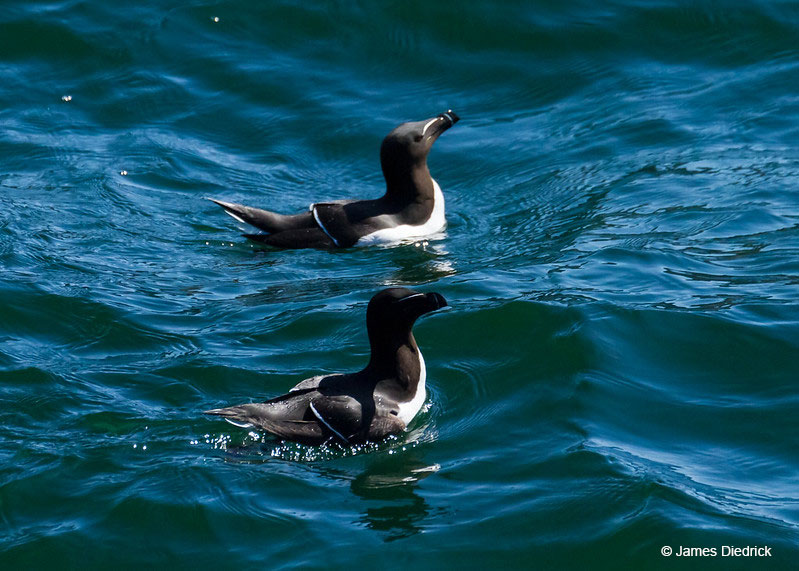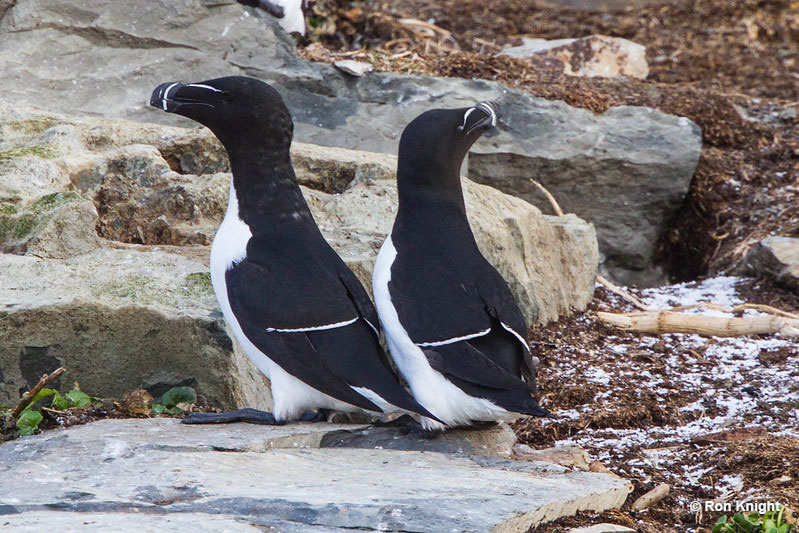Razorbills, also known as razor-billed auks or lesser auks, are a striking and unique species of seabird known for their sharp, hatchet-shaped bills and strong swimming abilities.
Found along the rocky coastlines of the North Atlantic, these birds nest in large colonies and can often be seen diving deep into the ocean in search of fish.
With their sleek black-and-white plumage and distinctive bills, razorbills are a striking sight both in the wild and in captivity.
On this page
Identification
Adult Razorbills look the same and have no differences between sexes. It has a black-and-white plumage, a long and graduated tail, and a thick black bill with a blunt end.
It’s about the same size as a crow, growing up to 14.5-15.3 inches long, and having a wingspan of 7-8.3 inches. The bill has several vertical grooves near the tip, one of them being white. Razorbills call with low, nasal growls and croaks.
Their plumage changes depending on whether it is the breeding season or not. During the breeding season, the Razorbill has a black head, back, neck, and feet and a white belly. They also have a thin white line extending from their bill to their brown eyes.
During the non-breeding season or in the case of a juvenile Razorbill, the bill gets thinner and grooves less prominent, including the white one. The throat and face behind the eye, on the other hand, become white.
You can see Razorbills flying, although they spend most of the year at sea, either bobbing at the surface or swimming underwater in search of food. It flies with strong rapid wingbeats, although its takeoff from the water can appear rather clumsy.
Food
Razorbills are carnivores and mainly feed mid-water on small fish in schools. They fly in loose flocks, especially in the morning, surveying the area from the air, searching for prey and any threats, and maneuvering carefully before gracefully diving into the water.
Razorbills are adept swimmers and usually go 5-60 feet below the surface, swim under a school of fish, and then snatch them up when ascending. They will often swallow the fish, sometimes many, so as to prevent gulls from stealing their food.
Depending on the region, their diet may vary. Razorbills may also eat small crustaceans like northern grill, decapods, amphipods, and also bristleworms. Their main diet usually consists of fish and they prefer
Atlantic herring, capelin, and northern sandlance, but they also feed on sprat, hakes, butterfish, pilchard, stickleback, and various species of anchovy.
Nesting and Eggs
Razorbills nest in colonies and may sometimes mate for life. During displays, male Razorbills raise their head, point their bill up and growl, then bow deeply. Females sometimes do the same. During courtship, they touch each other’s bills and fly together in elaborate patterns.
After pairing up but before laying their eggs, about half of the females breed with other males before returning and breeding with their mates.
The nest site is chosen by a male, and it is typically a bit further away from the drop amongst boulders. Usually, the nest is on a ledge, or in a crevice in the cliff. The pair often uses the same spot. The birds don’t build a nest, per se, but some drag pebbles, surrounding vegetation, small bones, or feathers to line the depression in the ground, which can measure about 12 inches long and 7.5 inches wide.
The female Razorbill lays only one tan or whitish egg with dark blotches per breeding season. Both the male and female incubate it, which takes about 32-39 days.
After hatching, the young stay in the nest for 14-25 days. Both parents take turns bringing the nestling food with the other remaining near the nest.
Young Razorbills leave the nest before they can fly, following adults to the edge of a cliff, jumping down, and swimming away. The parents feed the young until they are independent.
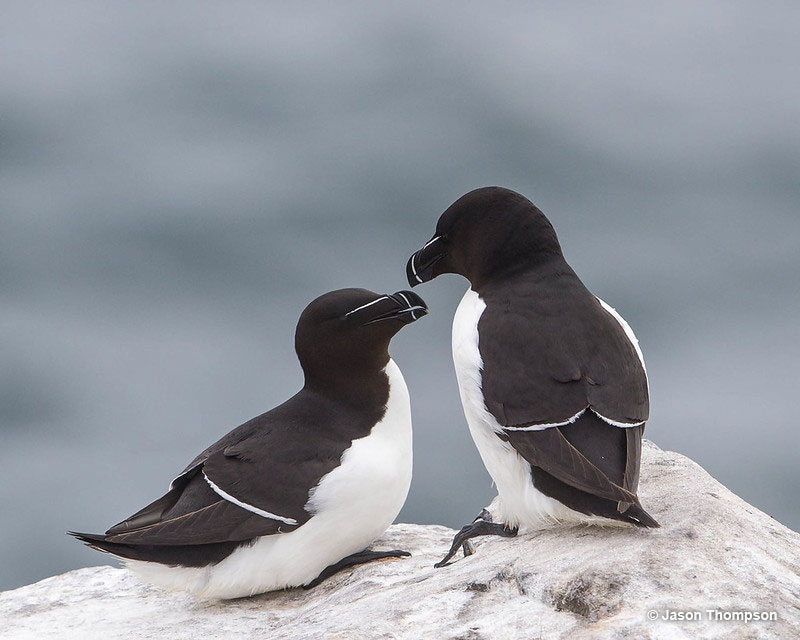
Younger Razorbills look similar to Dovekies, but Razorbills are easy to recognize thanks to their distinctive bills. © Jason Thompson
Current Situation
Razorbills range on the North Atlantic coastline. They breed on coasts from western Greenland and Hudson Strait to New England in the United States, staying between 73 and 43 degrees north.
It is a migratory bird, and, in the winter, the northern populations move south and can be seen from Newfoundland to southern New England. They are year-round residents in Britain.
Razorbill habitats include cliffs and offshore islands where the open ocean is right nearby. They need the water for foraging and the steep cliffs to provide protection.
Razorbills are listed as species of Least Concern on the IUCN Red List because, albeit their one-egg-per-season situation, their populations remain stable or are even slightly increasing. Threats to the survival of the species include hunting, entanglement in fishing gear, predation, oil pollution, pesticide poisoning, and climate change.
Facts
- Razorbills can live quite long, the oldest known specimen lived for 41 years. However, their average life expectancy is roughly 7-13 years.
- Razorbill pairs can mate up to 80 times a day over a 30-day period. This is most probably to ensure that the egg got fertilized since the female only lays one egg per season.
- Although both the male and female from a mating pair may copulate with other members of the species, then both partners are highly protective and aggressive to prevent it from happening.
- Razorbills start breeding only after reaching 3-5 years of age. They first practice courting and strengthen their pair bond. Older pairs occasionally skip a year of breeding.
Similar Species
Razorbills have two species that you can mix them up with, although none of them have the magnificent bill the bird in question does. Look at the list down below to see how to distinguish them!
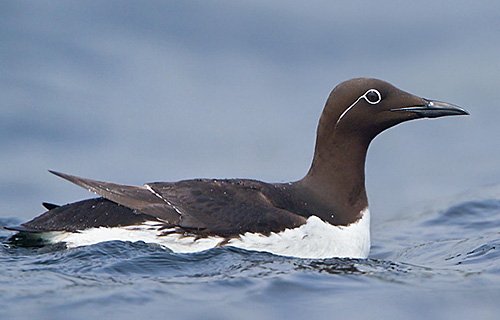
Common Murre. Photograph © Glenn Bartley.
Common Murre – As with Razorbills, the Common Murres also have breeding and non-breeding plumage, both of which are similar respectively.
Common Murres are slenderer overall and the white line on their face surrounds their eye. They also have a thinner and pointed bill, whereas a Razorbill’s bill is thick and blunt.
The non-breeding variants are similar in their plumage, but again, the Common Murres are slenderer and have a thinner and pointed bill.
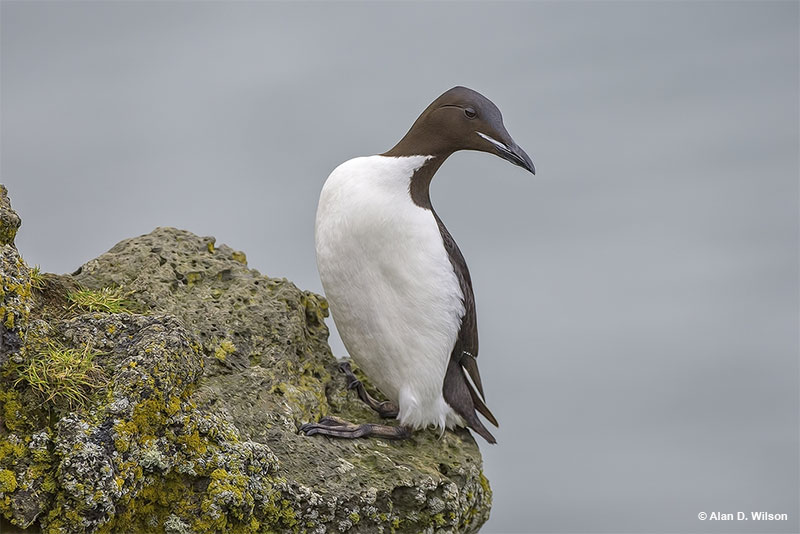
Thick-billed Murre
Thick-Billed Murre – Thick-Billed Murres also have breeding and non-breeding plumage.
When distinguishing them in their breeding plumage, you should look for pointier and thinner bills that don’t have the white vertical stripe that the Razorbill has.
They also have a short white horizontal line running from the base to about halfway on its bill, whereas the Razorbill’s line runs a bit higher and to its eye.
The nonbreeding Thick-Billed Murres have a black head and cheeks instead of the white cheeks the Razorbill has.
Frequently Asked Questions
Is a Razorbill a penguin?
Razorbills are not penguins, and they belong to different families, Razorbills to Alcidae and penguins to the Spheniscidae family. They look similar and both are powerful swimmers, but Razorbills, unlike penguins, can fly.
Why are they called Razorbills?
Razorbill is named after its unique bill because the edges of its upper beak are very sharp – a useful tool against predators and prey.
How deep can a Razorbill dive?
Razorbills have been observed to dive up to a depth of 330 feet, but mostly feed at a depth of 5-60 feet.

